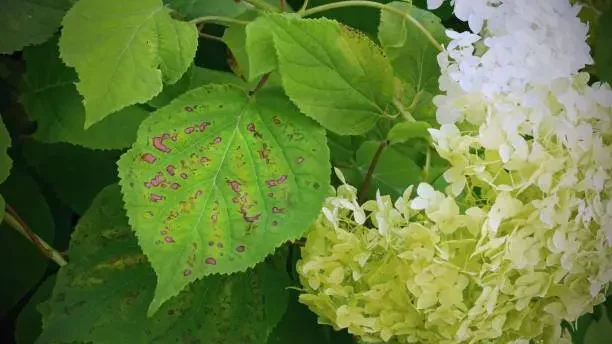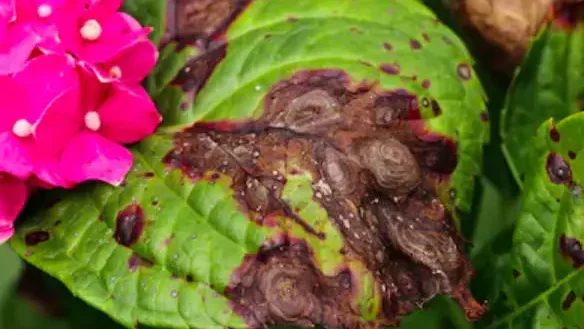Brown Spots On Hydrangeas – Causes & Treatment

Hydrangeas are prevalent in most homes due to their big clusters of beautiful blue, pink, and white flowers that bloom in the summer. This flowering shrub comes in different varieties giving its leaf shape and flower distinct colors.
All these varieties have one thing, a common enemy – fungal infections, bacteria, and pests.
This post highlights some common fungal and bacterial infections that cause brown spots on hydrangeas or called bacterial leaf spots. We’ll also examine what steps to take to address this challenge and how to ensure your garden maintains a striking look.
Cercospora Spots on Hydrangeas Leaf
Cercospora leaf spot is an infection that occurs when leaves are in regular contact with water due to irrigation or rain. Hence, this results in brown spots appearing on the hydrangea leaves.
It begins as a tiny purple or brown spot on the leaves close to its base. They have a diameter of 1/8″ to 1/4″ and appear scattered throughout the leaves. They also form gray or tan centers, which are then engulfed by purple or brown halos.
The leaves eventually become yellow-green and drop if nothing is done to contain this infection.
Although incidences of the Cercospora leaf spot-killing plant are rare, severe leaf spotting and premature leaf shed may lead to a reduction in the flower bud and plant’s vigor that occurs during the season.
Prevention and control of Cercospora Leaf Spot
The following are a few ways to deal with the spread of Cercospora leaf spot:
- Avoid splashing water on the hydrangea leaves when watering.
- As you water the soil, ensure you do so in adequate proportions to avoid having wet or soggy surroundings.
- Reduce the frequency you deep-soak your plant so the soil can dry between watering intervals.
- Get rid of all the heavily spotted or dead leaves.
- Apply a tree type and shrub fertilizer to the hydrangeas plant to maintain a growth rate.
- Avoid using the fertilizer after two months before the average first frost date around your region.
- Use a protective fungicide to spray on areas where you notice the signs of this infection to control its spread.
Cercospora leaf spot illness does not show up until mid and late summer.
Additionally, if the plant suffers from any visible damage, you’ll need a copper-based fungicide as this helps treat this condition.
The best time to treat this disease is either during early summer or late spring when the symptoms are visible. Also, check the product label to know the mixing and application guidelines.
Hydrangeas Anthracnose

Anthracnose usually appears in the landscape and typically infects only the bigleaf hydrangea (also known as “French” hydrangea or “mophead”). This leaf disease creates a big snowball-shaped cluster of flowers with shades of white, red, pink, or blue.
While this infection is primarily prevalent in extensive field plantations or greenhouses of carefully managed hydrangea, outbreaks can extend to residential areas and affect your garden.
The fungi responsible for this disease are the Colletotrichum gloeosporioides. They attack the hydrangea blooms and leaves.
The conditions that favor the spread of brown spots on the hydrangeas plant are a wet environment and hot weather. Heavily fertilized plants are also more prone to this infection.
The first sight of the brown spots on hydrangeas is irregular, circular, and slightly sunken on the plant’s fleshy leaves. At the center of these leaves, these spots may reach a diameter of one inch or more and start changing in color from light brown to tan.
If the conditions that favor the development of this disease persist, the big, irregular, dark brown spots will quickly spread across the flower petals and leaves of the hydrangeas.
Finally, the symptoms of this infection sometimes appear almost at once on both the blooms and leaves in the upper and lower areas of this plant.
Prevention and control of the Anthracnose
The following measures will help counter the spread of this infection:
- Gather all the fallen infected leaves and remove the destroyed blooms as recommended.
- Avoid splashing water on the leaves while watering the plant and instead direct the water towards the plant’s base area.
- Use a copper-based fungicide to spray the flowers and foliage according to the directions. Spray the foliage and blooming flowers the following summer before the brown spots started showing on the hydrangeas.
Hydrangea Rust (Pucciniastrum Hydrangea)

When a hydrangea leaf gets infected with this disease, you will find yellow spots on the top and orange spots below. As time passes, the color of the leaves will eventually turn brown, and then the leaves will finally fall off.
One way to control this disease is by cleaning all sections of the sick debris and leaves that have already fallen from the hydrangeas plant.
If you discover that the rust is persistent, you should get a cultivar, “Frosty,” which is more resistant to this infection.
How do you treat hydrangea rust?
This leaf disease usually spreads due to the splashing of water on the hydrangea plant leaves, which mostly happens as you water the plants.
Therefore, while watering, you should always confirm that you are spraying the water towards the plant’s base to try your best and ensure the leaves above remain completely dry.
Likewise, you can also remove all the disease-infested leaves if the condition is not very serious, which will be enough to prevent the spread of rust. However, if the issue is severe, you may need to use fungicide for this disease.
Hydrangea Leaves Edges Turning Brown

Hydrangea plants that have either been planted recently or growing in a pot are often susceptible to intense fertilizer use. As a result, you may begin to notice yellow and eventually brown color around the edges and the tip a day or two after applying the fertilizer.
Also, the roots of this plant may have suffered from slight burning. Furthermore, Aluminum sulfate, which occasionally gets added to the soil, changes the hydrangea bloom color and causes root damage if you apply too much of it.
How do you treat the leaves and edges of the hydrangea plant turning brown?
If you want to treat the brown spots from your hydrangeas plant, you need to flush the soil surrounding it with water, regardless of whether it is on the ground or in a pot.
Doing this removes almost all of the salts found in the soil. Consequently, you should not water your hydrangea plant for about one or two days to ensure the soil on the surface is somewhat dry. After that, you should start watering your plant as usual.
Nonetheless, if your hydrangea plant grows from the container, confirm that all the water drains from below the pot after completing each watering. This is vital as it will flash out the salts regularly.
Additionally, it would be best to only fertilize your hydrangeas plant after a root burn once it looks healthy, as this indicates that it is now healthy and the root system is well-developed.
Powdery Mildew Showing on the Hydrangea Leaves

This is another reason for the appearance of brown spots on hydrangea leaves. Fortunately, identifying it is easy as it starts with having a powdery, pale gray coating.
It usually spreads through spores from one plant to another, which can escalate if adequate measures are not taken.
The spores generally transfer during cold nights and hot days, and enormous swings in temperature are significant factor that aids the spread of this disease.
Some of the causal agents of this infection include:
- Golovinomyces Orontii
- Oidium Hortensia
- Microsphaera Friesii
- Erysiphe Poeltii.
How do you treat powdery mildew on the hydrangea leaves?
One of the best techniques for combating this fungus is by taking off the infected leaves or any other plant part. While at it, ensure you are only removing the affected area.
And as you water the plant, focus on the base to prevent the leaves from getting wetter, thereby quickening the spread of these fungi.
Additionally, it would help if you made it a duty to water in the morning as this gives the leaves ample time to dry before the temperature drops later in the day.
If you are looking to kill the fungus, use an organic treatment and carefully follow the written instructions.
Hydrangea Leaves Becoming Yellow

Sometimes, the leaves suddenly turn yellow and brown during the hydrangea’s growing season – summer or spring. Subsequently, they start falling off. This is caused by an infection that is common with plant roots.
It usually happens when the plant has had enough time to develop a deep and robust root system, for instance, before the hydrangea is transplanted from the pot or after that.
The three most common causes include;
- The plant is continuously kept very wet
- Excessive dryness of the plant
- Excess fertilizer in the plant
Any of these can result in the death of a part or the entire root system, and once this happens, the leaves start to wilt, turn yellow, and eventually brown.
Keeping your plants fruit trees extremely wet also results in rotting and eventual death.
Bottom Line
Once you allow the plant to dry completely, you must exhaustively water the root system. If you still have the hydrangea in a pot, place it in the water tub and rim it until every dry root has been soaked.
Moreso, it’d be best to allow the plant to drain completely. Because since the roots are damaged, they’ll struggle with incredibly wet soil.
Therefore, ensure you give some time between every watering interval to allow the soil to dry out, enhancing the roots’ regeneration.